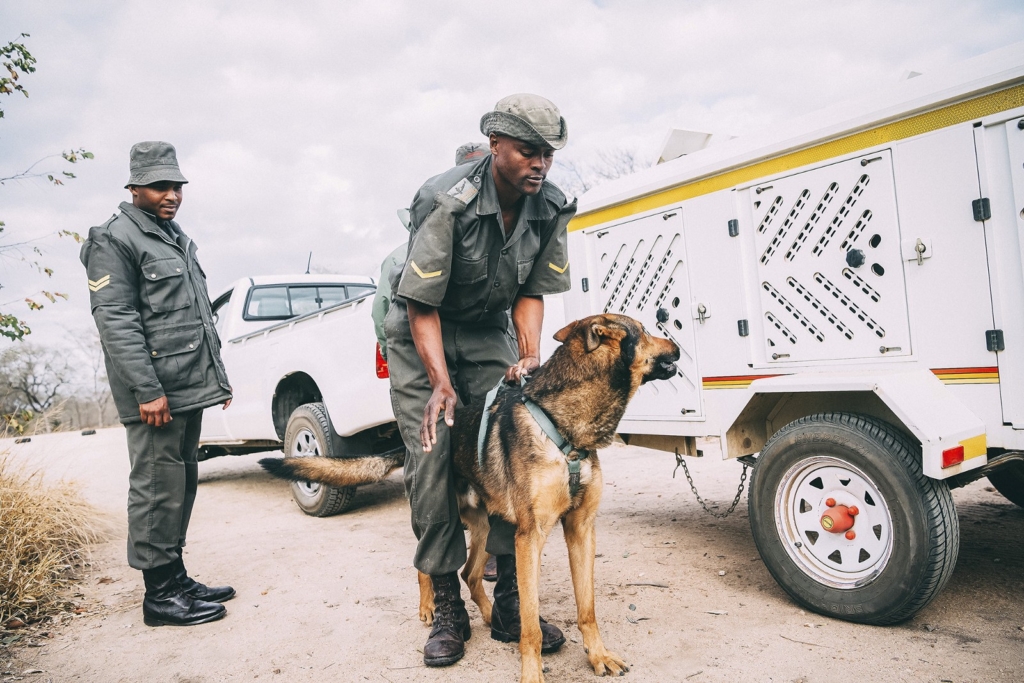If you’re struggling for a gift for your nature-loving friend or family member this Christmas, why not consider giving the gift of conservation by supporting a nature non-for-profit. Below is a list of our favourite, conservation non-for-profits that we have supported this year.
Support Rangers

Rangers in the K9 unit at the Southern African Wildlife College. © Kirstin Scholtz
The Southern African Wildlife College equips students with skills in conservation and wildlife management across Southern Africa, as well as internationally and trains up to 2000 students per year. The poaching crisis has put an even more significant responsibility on the SAWC to equip their students with the appropriate skills to tackle poaching at every level.
Their four-tier approach includes equipping field rangers with the necessary skills to help counter the onslaught of wildlife crime in the region; its air wing unit provides aerial surveillance to plot and monitor rhino movements and suppress poachers; its K9 unit adds tracker and apprehensions dogs to field ranger teams and; its community engagement projects engender support and buy-in from local communities for wildlife protection.
Support Elephants

Elephant feeding in Mana Pools, Zimbabwe. © Kirstin Scholtz
Mana Pools Zimbabwe has seen a dramatic decline in elephant populations over recent years, with an estimated 50% loss over the past due years. The mismanagement of hunting quotas as well as, an increase in poaching are the leading cause. Bushlife Conservancy is out to protect elephants and other wildlife for future generations. Their priority is to provide equipment and logistical support as well as coordinate efforts for anti-poaching teams to arrest and detain poachers. They also offer constant monitoring and tracking of elephant herds, establishing ongoing ranger presence and provide funding to support local community health, welfare and education.
Support Australian Wildlife

Endangered Australian Bilby. © Dcoetzee , via Wikimedia Commons
Australia has the worst mammal extinction rate in the world. The Australian Wildlife Conservancy has built a network of sanctuaries across Australia for the sole purpose of preserving and repopulating Australia’s unique wildlife. Led by CEO Atticus Flemming, the AWC is a magnificent example of a successful conservation initiative that has a resume worthy of the great global wildlife operators. Their model is to establish sanctuaries through partnerships with landowners and to implement practical land management, feral animal control, and fire management. They manage 27 properties, and protect endangered wildlife across more than 4.6 million hectares in iconic regions such as the Kimberley, Cape York, Lake Eyre and the Top End. They are responsible for protecting the most significant populations of endangered species.
Support Conservation Education

Anglehead Lizzard, South Sumatra. © Pungky Nanda Pratama
Logging and poaching are tearing at the heart of the tropical forests of South Sumatra, Indonesia. Virgin rainforests are being destroyed and wildlife, wrenched into the illegal wildlife trade or killed to make way for plantations. Faced with higher living costs, indigenous people who live on the border of Indonesia’s last green wildernesses are being forced to cut, traffic and sell their natural wealth. The Jungle Library Project is an environmental education initiative run by a young environmental educator Pungky Nanda Pratama that teaches primary school children species identification, ecosystem function and the dangers of environmental destruction. The aim is to inspire future leaders to make better choices for the environment. The initiative is supported by The Nature and Biodiversity Conservation Agency of South Sumatra (NBCASS) and the head of the Conservation Agency of Kerinci Seblat National Park and has seen significant results.
Support Alaskan Wilderness and Wildlife

WildArk Ambassador Mick Fanning fishing in Bristol Bay, Alaska. © Kirstin Scholtz
North America’s Bristol Bay, Alaska is home to the largest, wild salmon fishery in the world. It’s rivers see an abundance of wild salmon return each year, breathing life into the ecosystem and bringing food for wildlife such as bears, bald eagles and more. Tragically, Bristol Bay is threatened by the massive proposed gold and copper open pit mine known as Pebble. Working closely with local fisherman, tribes, commercial fisherman, sportsmen and women, Save Bristol Bay, run by Trout Unlimited is working to protect these iconic rivers and the people and wildlife they support.
Support Turtles

Rehabilitated turtles are released back into the wild by the Local Ocean Trust. © LOT
Kenya’s Watamu Bay has been identified as one of the most critical nesting sites for turtles including Green Turtles, Olive Ridley, and Hawksbill turtles. Unfortunately, these turtles are under threat as by-catch by local fisherman, from rampant poaching, loss of nesting areas due to commercial beach activity and illegal development causing bright lights on the beach that disorientate turtles when nesting. The Local Ocean Trust uses practical conservation, community involvement and development, education, research and campaigning to promote the sustainable use of Kenya’s marine resources. The Watamu Turtle Watch is their flagship programme and consists of Nest Monitoring and Protection, By-Catch Net Release, and has a specialist Rehabilitation Centre for the sick and injured sea turtles. The combination of these programmes enables the LOT to make a real difference in ensuring the future of endangered sea turtles.
